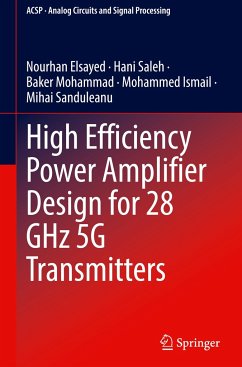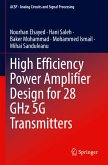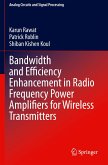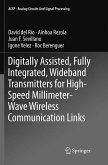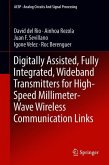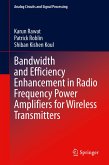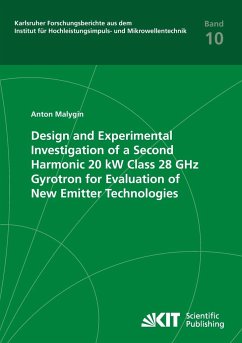Nourhan Elsayed, Hani Saleh, Baker Mohammad
High Efficiency Power Amplifier Design for 28 GHz 5G Transmitters
Nourhan Elsayed, Hani Saleh, Baker Mohammad
High Efficiency Power Amplifier Design for 28 GHz 5G Transmitters
- Gebundenes Buch
- Merkliste
- Auf die Merkliste
- Bewerten Bewerten
- Teilen
- Produkt teilen
- Produkterinnerung
- Produkterinnerung
This book introduces power amplifier design in 22nm FDSOI CMOS dedicated towards 5G applications at 28 GHz and presents 4 state-of-the-art power amplifier designs. The authors discuss power amplifier performance metrics, design trade-offs, and presents different power amplifier classes utilizing efficiency enhancement techniques at 28 GHz. The book presents the design process from theory, simulation, layout, and finally measurement results.
Andere Kunden interessierten sich auch für
![High Efficiency Power Amplifier Design for 28 GHz 5G Transmitters High Efficiency Power Amplifier Design for 28 GHz 5G Transmitters]() Nourhan ElsayedHigh Efficiency Power Amplifier Design for 28 GHz 5G Transmitters66,99 €
Nourhan ElsayedHigh Efficiency Power Amplifier Design for 28 GHz 5G Transmitters66,99 €![Charge-based CMOS Digital RF Transmitters Charge-based CMOS Digital RF Transmitters]() Pedro Emiliano Paro FilhoCharge-based CMOS Digital RF Transmitters66,99 €
Pedro Emiliano Paro FilhoCharge-based CMOS Digital RF Transmitters66,99 €![Bandwidth and Efficiency Enhancement in Radio Frequency Power Amplifiers for Wireless Transmitters Bandwidth and Efficiency Enhancement in Radio Frequency Power Amplifiers for Wireless Transmitters]() Karun RawatBandwidth and Efficiency Enhancement in Radio Frequency Power Amplifiers for Wireless Transmitters93,99 €
Karun RawatBandwidth and Efficiency Enhancement in Radio Frequency Power Amplifiers for Wireless Transmitters93,99 €![Digitally Assisted, Fully Integrated, Wideband Transmitters for High-Speed Millimeter-Wave Wireless Communication Links Digitally Assisted, Fully Integrated, Wideband Transmitters for High-Speed Millimeter-Wave Wireless Communication Links]() David del RioDigitally Assisted, Fully Integrated, Wideband Transmitters for High-Speed Millimeter-Wave Wireless Communication Links116,99 €
David del RioDigitally Assisted, Fully Integrated, Wideband Transmitters for High-Speed Millimeter-Wave Wireless Communication Links116,99 €![Digitally Assisted, Fully Integrated, Wideband Transmitters for High-Speed Millimeter-Wave Wireless Communication Links Digitally Assisted, Fully Integrated, Wideband Transmitters for High-Speed Millimeter-Wave Wireless Communication Links]() David del RioDigitally Assisted, Fully Integrated, Wideband Transmitters for High-Speed Millimeter-Wave Wireless Communication Links116,99 €
David del RioDigitally Assisted, Fully Integrated, Wideband Transmitters for High-Speed Millimeter-Wave Wireless Communication Links116,99 €![Bandwidth and Efficiency Enhancement in Radio Frequency Power Amplifiers for Wireless Transmitters Bandwidth and Efficiency Enhancement in Radio Frequency Power Amplifiers for Wireless Transmitters]() Karun RawatBandwidth and Efficiency Enhancement in Radio Frequency Power Amplifiers for Wireless Transmitters93,99 €
Karun RawatBandwidth and Efficiency Enhancement in Radio Frequency Power Amplifiers for Wireless Transmitters93,99 €![Design and Experimental Investigation of a Second Harmonic 20 kW Class 28 GHz Gyrotron for Evaluation of New Emitter Technologies Design and Experimental Investigation of a Second Harmonic 20 kW Class 28 GHz Gyrotron for Evaluation of New Emitter Technologies]() Anton MalyginDesign and Experimental Investigation of a Second Harmonic 20 kW Class 28 GHz Gyrotron for Evaluation of New Emitter Technologies42,00 €
Anton MalyginDesign and Experimental Investigation of a Second Harmonic 20 kW Class 28 GHz Gyrotron for Evaluation of New Emitter Technologies42,00 €-
-
-
This book introduces power amplifier design in 22nm FDSOI CMOS dedicated towards 5G applications at 28 GHz and presents 4 state-of-the-art power amplifier designs. The authors discuss power amplifier performance metrics, design trade-offs, and presents different power amplifier classes utilizing efficiency enhancement techniques at 28 GHz. The book presents the design process from theory, simulation, layout, and finally measurement results.
Produktdetails
- Produktdetails
- Analog Circuits and Signal Processing
- Verlag: Springer / Springer International Publishing / Springer, Berlin
- Artikelnr. des Verlages: 978-3-030-92745-5
- 1st edition 2022
- Seitenzahl: 112
- Erscheinungstermin: 3. Februar 2022
- Englisch
- Abmessung: 241mm x 160mm x 12mm
- Gewicht: 342g
- ISBN-13: 9783030927455
- ISBN-10: 3030927458
- Artikelnr.: 62897845
- Herstellerkennzeichnung Die Herstellerinformationen sind derzeit nicht verfügbar.
- Analog Circuits and Signal Processing
- Verlag: Springer / Springer International Publishing / Springer, Berlin
- Artikelnr. des Verlages: 978-3-030-92745-5
- 1st edition 2022
- Seitenzahl: 112
- Erscheinungstermin: 3. Februar 2022
- Englisch
- Abmessung: 241mm x 160mm x 12mm
- Gewicht: 342g
- ISBN-13: 9783030927455
- ISBN-10: 3030927458
- Artikelnr.: 62897845
- Herstellerkennzeichnung Die Herstellerinformationen sind derzeit nicht verfügbar.
Nourhan Elsayed received her PhD Degree in Electrical and Computer Engineering in 2020, Khalifa University. She received her BSc. in Electrical and Electronics Engineering in 2014 from Khalifa University, Abu Dhabi, UAE. She then received her MSc. in Electrical Engineering from The Petroleum Institute, Abu Dhabi, UAE in 2016. Nourhan's research work is in RF circuit design, specifically high efficiency transmitter design for 5G applications. She has been working on multiple mm-wave designs in 22nm FDSOI including switching amplifiers and efficiency enhancement techniques. Hani Saleh (SM'16) is an assistant professor of electronic engineering at Khalifa University since Jan, 2012. He is an active member in KSRC (Khalifa University Research Center) where he leads a project for the development of wearable blood glucose monitor SOC and a mobile surveillance SOC and safe exercise monitoring device. Hani published 81 articles in peer-reviewed journals and conferences, he has 11 issued US patents and 3 pending patent applications. Hani has a total of 19 years of industrial experience in ASIC chip design, microprocessor design, DSP core design, graphics core design and embedded system design. His experience spans DSP core design, microprocessor peripherals design, microprocessors and graphics core deign. Prior to joining Khalifa University he worked as a Senior Chip Designer (Technical Lead) at Apple incorporation; where he worked on the design and implementation of Apple next generation graphics cores for its mobile products (iPad, iPhone, ...etc.), prior to joining Apple, he worked for several leading semiconductor companies including Intel (ATOM mobile microprocessor design), AMD (Bobcat mobile microprocessor design), Qualcomm (QDSP DSP core design for mobile SOC's), Synopsys (a key member of Synopsys turnkey design group where he taped out many ASICs and designed the I2C DW IP included in Synopys DesignWare library), Fujitsu (SPARC compatible high performance microprocessor design) and Motorola Australia (M210 low power microprocessor synthesizable core design). Baker Mohammad (M'04-SM'13) received the B.S. degree from the University of New Mexico, Albuquerque, NM, USA, the M.S. degree from Arizona State University, Tempe, AZ, USA, and the Ph.D. degree from the University of Texas at Austin, Austin, TX, USA, in 2008, all in electricaland computer engineering. He was a Senior Staff Engineer and the Manager with Qualcomm, Austin, where he was involved in designing high performance and low power DSP processor used for communication and multimedia application. He was involved in a wide range of microprocessors design with Intel Corporation, Santa Clara, CA, USA, from high performance, server chips >100 W (IA-64), to mobile embedded processor low power sub-1 W (xscale). He has over 16 years of industrial experience in microprocessor design with an emphasis on memory, low power circuit, and physical design. He is currently an Assistant Professor of Electronic Engineering with the Khalifa University of Science, Technology and Research, Abu Dhabi, United Arab Emirates, and a Consultant with Qualcomm Inc., San Diego, CA, USA. In addition, he is involved in microwatt range computing platform for WSN focusing on energy harvesting and power management, including efficient dc/dc and ac/dc converters. He holds ten issued U.S. patents and has several pending patent applications. He has authored one book entitled Embedded Memory Design for Multi-Core and SoC and co-authored several publications in digital system design, memory design and testing, energy harvesting, power management, and power conversion, in addition to emerging memory technology modeling and design. His current research interests include power efficient computing, highyield embedded memory, and emerging technology, such as memristor, STTRAM, and computer architecture. Dr. Mohammad has served the IEEE in many editorial and administrative capacities. He is a member of the Technical Program Committee of several IEEE conferences, such as the International Conference on Computer Design, the International Conference on Environmental and Computer Science, and the VLSI-SoC Conference. He is a Regular Reviewer of the IEEE TRANSACTIONS ON VLSI SYSTEMS and the IEEE TRANSACTIONS ON DESIGN AUTOMATION OF ELECTRONIC SYSTEMS. He is an Active Member of region eight student activities, including the Student Best Paper Competition, the UAE Chapter Student Day, and the KUSTAR Student Branch Advisor. Dr. Mihai Sanduleanu received his MSc, MEE and PhD degrees from the Technical University of Iasi, Romania; Eindhoven University of Technology, The Netherlands; and the University of Twente, The Netherlands; in 1990, 1993 and 1999, respectively. Hereceived the Philips Foundation MSc and PhD Fellowship in 1993 and 1994 respectively. From 1999 to 2000, Dr. Sanduleanu was with Philips Semiconductors, Nijmegen, The Netherlands, and he worked on fiber optic communication circuits. He then moved to Philips Research Eindhoven, The Netherlands, and was involved in fiber optic interface circuits, radio frequency (RF) interconnected chip (IC) design, mm-waves transceiver design and ultra-low power radios (2000-2007). While at Philips Research, Dr. Sanduleanu was Adjunct Professor in the Microelectronics group of Eindhoven University of Technology. In 2008, he spent six months at Inter-university Microelectronics Center (IMEC), Leuven, Belgium, conducting research on 60GHz transceiver design and THz electronics. From 2008 to 2013, he conducted research at the IBM T.J. Watson Research Center, Yorktown Heights, New York, in mm-wave transceivers for communication, imaging and radar, high-speed analog-to-digital convertersfor wired/wireless communication systems and ultra-low power radios. Dr. Sanduleanu is currently an Associate Professor at Khalifa University. His areas of expertise include wireless transceiver design for RF/mm-waves/THz communication, THz electronics, high speed communication circuits for serial input and output, high speed analog-to-digital converters, phased-array systems, imaging, fiber optic interface IC, ultra-low power radios, data and clock recovery and phase locked loop (PLL), high accuracy/low-power analog/mixed-signal circuits and systems, system on chip (SoC) design, on-chip sensors and actuators for autonomous transceivers (wired/wireless), high-speed digital circuits and systems, electromagnetics, and antenna design. Dr. Sanduleanu has authored/co-authored four books and more than 80 papers in international conferences and journals. He also holds 51 granted US patents. Dr. Sanduleanu served as Associate Editor for IEEE Transactions on Circuits and Systems and he serves in the Editorial Board of the Analog Integrated Circuits and Signal Processing Journal. Mohammed Ismail (S'80-M'82-SM'84-F'97) spent over 25 years in academia and industry in the U.S. and Europe. He served as a Faculty Member with the Ohio State University's (OSU) ElectroScience Laboratory, Columbus, OH, USA. He was a Research Chair with the Swedish Royal Institute of Technology, Stockholm, Sweden, where he founded the Radio and Mixed Signal Integrated Systems Research Group. He held visiting appointments with Aalto University, Espoo, Finland, the Norwegian Institute of Technology, Trondheim, Norway, the University of Oslo, Oslo, Norway, Twente University, Enschede, The Netherlands, and the Tokyo Institute of Technology, Tokyo, Japan. He joined the Khalifa University of Science, Technology and Research, Abu Dhabi, United Arab Emirates, in 2011, where he holds the ATIC Professor Chair and is the Head of the Electricaland Computer Engineering Department, which exists on both campuses in Sharjah and Abu Dhabi. He advised the work of over 50 Ph.D. degree students and over 100 M.S. degree students. He has served as a Corporate Consultant to over 30 companies and is the Co-Founder of Micrys Inc., Columbus, Spirea AB, Stockholm, Firstpass Technologies Inc., Dublin, OH, USA, and ANACAD (currently part of Mentor Graphics), Cairo, Egypt. He is currently a prolific author and an entrepreneur in chip design and test. He is the Founder of the OSU's Analog VLSI Laboratory, one of the foremost research entities in the field of analog, mixed signal, and RF integrated circuits. He serves as the Director of KSRC and the Co-Director of the ATIC-SRC Center of Excellence on Energy Efficient Electronic Systems targeting self-powered chip sets for wireless sensing and monitoring, biochips, and power management solutions. He has authored or co-authored over 20 books and over 150 journal publications and holds eight U.S.patents issued and several pending. His current research interests include self-healing design techniques for CMOS RF and millimeter wave ICs in deep nanometer nodes. Prof. Ismail received the U.S. Presidential Young Investigator Award, the Ohio State Lumley Research Award four times in 1992, 1997, 2002, and 2007, and the U.S. Semiconductor Research Corporations Inventor Recognition Award twice. He is the Founding Editor of the Journal of Analog Integrated Circuits and Signal Processing (Springer) and serves as the Journals Editor-in-Chief. He has served the IEEE in many editorial and administrative capacities. He is the Founder of the IEEE International Conference on Electronics, Circuits and Systems and the Flagship Region 8 Conference of the IEEE Circuits and Systems Society.
Introduction.- Power Amplifier Fundamentals.- Doherty Power Amplifier Design.- Stacked Class-E Power Amplifier.- Doherty Class-E Power Amplifier.- Inverse Class-D Power Amplifier.- Phased-Array transmitter.
Introduction.- Power Amplifier Fundamentals.- Doherty Power Amplifier Design.- Stacked Class-E Power Amplifier.- Doherty Class-E Power Amplifier.- Inverse Class-D Power Amplifier.- Phased-Array transmitter.

